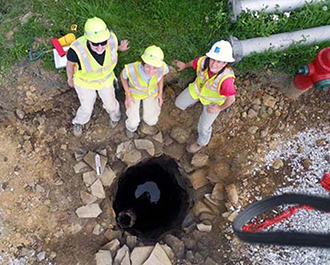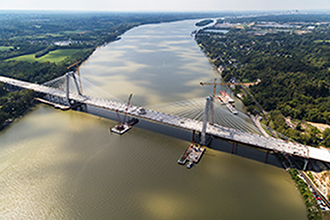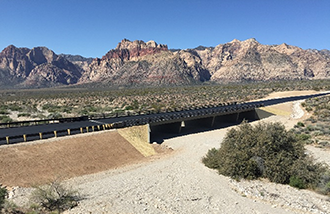
2017 FHWA Environmental Excellence Award Winners
Demonstrate Budget-Friendly Best Practices in Stewardship
EEA Recipients Span Three Topic Areas
The EEAs recognize winners across three topic areas: Organization and Process Innovation, Human Environment, and Natural Environment.
The Organization and Process Innovation topic area recognizes projects that contribute to innovations in environmental streamlining, research, and education. 2017 awardees include projects that demonstrated excellence in archeological preservation, stormwater quality improvement, and research on the environmental effects of road dust control products.
Awardees in the Human Environment topic area include transportation projects and programs that positively impact social, economic, and cultural aspects of the environment and communities. The 2017 Human Environment award winners include projects that preserved tribal and cultural resources, deployed innovative community engagement strategies, and established a bicycle and pedestrian rail trail for commuters.
The Natural Environment topic area highlights transportation projects and programs that protect and enhance ecosystems and improve air and water quality. The 2017 award winners included projects that measured and assessed air quality, protected threatened species, and improved stormwater management and treatment.
The Federal Highway Administration (FHWA) recently announced the winners of the 2017 Environmental Excellence Awards (EEAs). This year’s awards recognize 18 projects from across the country that go beyond environmental compliance to achieve environmental excellence. The award recipients excelled in a wide range of environmental areas, such as improving stormwater management, enhancing ecosystems around roadways, and preserving cultural and historic resources. These projects not only meet environmental requirements such as those in the National Environmental Policy Act (NEPA) and the National Historic Preservation Act, but they also excel in advancing innovations and best practices that protect and enhance the natural and human environment and help accelerate project delivery. This issue of Successes in Stewardship highlights three projects that were awarded for their contributions to accelerating project delivery while benefiting the environment.
EEAs Recognize Environmental Excellence for Over 20 Years
Since 1995, the biennial EEAs have recognized projects, partners, and processes that protect and enhance the environment while meeting transportation needs. Nominations are accepted for any project, process, group, or individual that has used FHWA funding to make an outstanding contribution to transportation and the environment. In the 2017 award cycle, FHWA received applications from nearly 100 unique applicants. Applications were reviewed by a panel of independent judges. Projects were awarded in 16 categories spanning three topic areas: Organization and Process Innovation, Human Environment, and Natural Environment. Award recipients were recognized in an award ceremony at this year’s American Association of State Highway and Transportation Officials’ Standing Committee on the Environment meeting in Des Moines, Iowa. For a complete list of 2017 award winners as well as descriptions of these projects, visit the EEA website. Award recipients from past years are also available on the website.
PennDOT
Preserves Archeological Resources While Cultivating Future Public Servants

The PennDOT PHAST includes graduate and undergraduate students who work with PennDOT cultural resources managers and environmental staff on all aspects of transportation archaeology.
(Image courtesy of PennDOT)
The Pennsylvania Department of Transportation (PennDOT) Highway Archaeology Survey Team (PHAST) received a 2017 EEA in the Educational and Training Programs category of the Organization and Process Innovation topic area. PHAST is based at Indiana University of Pennsylvania and funded by an interagency cooperative agreement between PennDOT and the university. PHAST focuses on both project delivery and training the next generation of Cultural Resources Management (CRM) practitioners. The team consists of a paid graduate student field director and three paid undergraduate and graduate interns.
The PHAST field director and crewmembers are mentored and trained by PennDOT’s experienced cultural resource professionals and environmental staff in all aspects of transportation archaeology, including initial project scoping, fieldwork and analysis, production of final reports, and preparation and care of collections. In the process, the students are exposed to the complex balance of resource management considerations required by NEPA, the cycle of project development from planning to construction, and the nuances of CRM archaeology in the context of a large transportation agency.
PHAST focuses on identifying archaeological sites that may be affected by transportation projects. Most PHAST projects are conducted in the preliminary design phase of project development, and PHAST works with design teams to avoid or protect significant sites in final design and construction. The students and their professional mentors are responsible for everything from initial project area evaluation, analysis and reporting, to preparing artifact collections for final curation. The program has produced a cohort of experienced and dependable young practitioners who are employed in both the private and public sector, including at PennDOT and at the Pennsylvania State Historic Preservation Office.
Bi-State Bridge Project Minimizes Impacts through Extensive Community Engagement

Three alternate designs for both bridges were presented to the public and voted on through group meetings, online polls, and physical polling places.
(Image courtesy of HMB Professional Engineers, Inc.)
Innovative community outreach implemented as part of the Louisville-Southern Indiana Ohio River Bridges (LSIORB) project earned the Kentucky Transportation Cabinet, Kentucky Public Transportation Infrastructure Authority, the Indiana Department of Transportation, the Indiana Finance Authority, and the Kentucky and Indiana Divisions of FHWA a 2017 EEA in the Community Considerations in Transportation Improvements category of the Human Environment topic area. “Two Bridges – One Project” involved the construction of two new toll bridges over the Ohio River to address the long-term cross-river transportation needs in the Louisville-Southern Indiana region.
The culmination of more than 40 years of planning and community involvement, the 2,114-foot-long Downtown Crossing Bridge and the 2,500-foot-long East End Crossing Bridge comprise the largest bi-State transportation project undertaken by the States of Kentucky and Indiana. It’s also one of the largest transportation improvement projects in the United States. The project incorporated community consideration throughout the process such as seeking community input on the bridge design, minimizing construction impacts, and ensuring new tolls did not burden underserved populations. Throughout the design and construction process, more than 600 public meetings were held in accordance with the project’s public involvement plan. Community benefits provided as part of the project also included a Disadvantaged Business Enterprise Program, a workforce development program, the renovation of a historic property for community use, and $20 million in public transit improvements.
Red Rock Canyon Bridge Project Balances Improved Visitor Safety and Mobility with Environmental Stewardship

The final bridge designs incorporated context sensitive design to blend into and complement the natural landscape.
(Image courtesy of the Central Federal Lands Highway Division)
The FHWA Central Federal Lands Highway Division, the Federal Bureau of Land Management, CH2M, and Wadley Construction, Inc. received a 2017 EEA in the Roadside Resource Management and Maintenance category in the Natural Environment topic area. The agencies partnered on a multi-phase suite of improvements to address the modern transportation and tourism demands of the Red Rock Canyon National Conservation Area in Nevada, where visitation has increased fourfold since being designated a National Conservation Area in 1982. Project improvements included adding two bridges at low water crossings where debris flows during high precipitation events, installing a new flood warning system, and rehabilitating over 15 miles of roadway.
The project used stakeholder and community input to identify designs of minimal visual impact, and the bridges were developed to both blend into and complement the natural landscape. By eliminating roadway flooding and debris accumulation, the bridges reduce maintenance costs and improve safety. Through context sensitive design and stakeholder coordination, the bridges were built with little disturbance to the sensitive roadside vegetation and geology of the Mojave Desert. The improved safety and mobility for visitors and minimized impacts to the surrounding environment make the Red Rock Canyon Bridge project an example of award-winning environmental stewardship and interagency coordination.
FHWA Remains Committed to Recognizing Successes in Stewardship through the EEAs
The 2017 EEA award winners and applicants demonstrate a continued commitment among State and local governments and their partners to accelerate project delivery while benefiting the natural and human environment. These award winners are leaders in accelerating transportation project delivery, conducting innovative research, protecting natural and cultural resources, improving air and water quality, and incorporating community considerations into transportation planning. Over the past two decades the EEAs have recognized hundreds of projects across a variety of topic areas for their excellence in stewardship and will continue to do so with the next awards cycle. FHWA hopes that by recognizing these best practices, practitioners and agencies remain motivated or become inspired to test new methods that improve their processes while protecting the environment. FHWA will announce the application period for the 2019 awards in late 2018.
Look What’s New!
- The Office of Project Development and Environmental Review recently released eNEPA 2.0, the latest version of the free, web-based interagency collaboration tool for developing environmental documentation, such as an environmental impact statement or environmental assessment, needed for projects. Utilizing feedback received from users, the updated tool includes customizable workflows, improved document review functions, and a dashboard.
- The latest version of eNEPA, the free, web-based interagency collaboration tool for developing environmental documentation, is now available. Using feedback received from users,
HEPE
updated the tool to include customizable workflows, improved document review functions, and a dashboard.
Successes in Stewardship is a Federal Highway Administration newsletter highlighting current environmental streamlining and stewardship practices from around the country. Click here to subscribe, or call (617) 494-2013 for more information.

